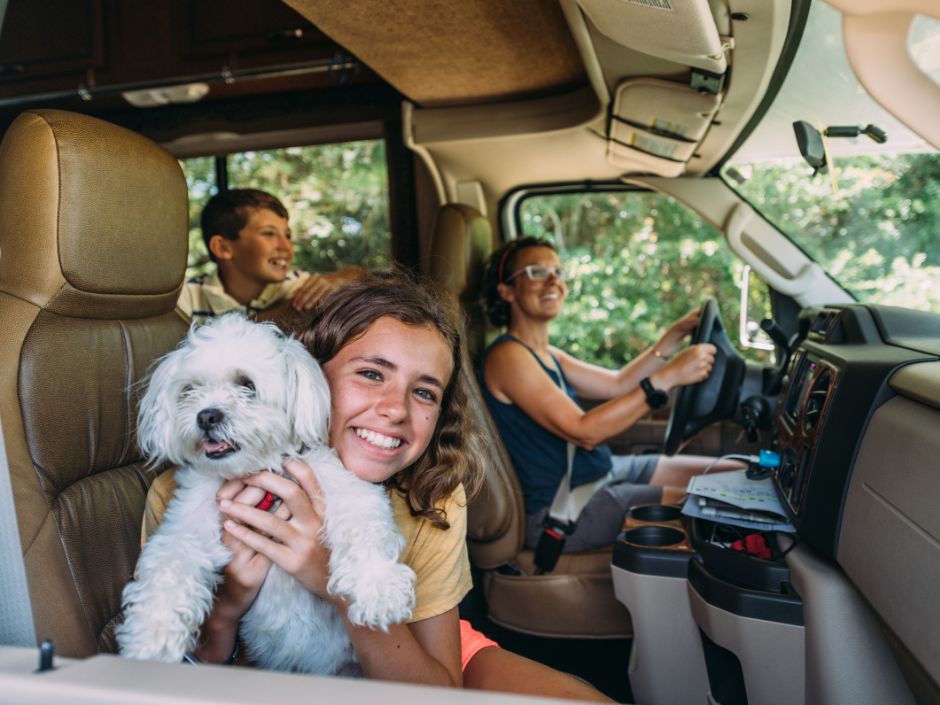RVing with your dog can be a wonderful experience, offering both you and your furry friend the chance to explore new places, enjoy the great outdoors, and create lasting memories together. However, RV travel with pets does require some preparation and planning. Here’s a guide to help ensure your dog stays happy and safe on the road.
1. Prepare Your RV for Your Dog
- Create a Comfortable Space: Designate a cozy spot in your RV where your dog can relax during the drive and while you’re parked. Bring along their favorite bed, blankets, and toys to make the space feel like home.
- Safety First: Invest in a dog seat belt or harness that attaches to the RV's seat belt system. This will keep your dog secure while you’re driving. Alternatively, a travel crate can provide added safety and comfort.
- Temperature Control: RVs can get hot or cold quickly. Ensure your RV is well-ventilated and consider using fans or portable air conditioning units. Never leave your dog alone in an RV without proper temperature control.
2. Pack the Essentials
- Food and Water: Bring enough of your dog’s regular food to last the entire trip. Changing their diet suddenly can lead to digestive issues. Don’t forget their water bowl and consider a portable one for hikes and outings.
- Health and Safety Gear: Pack a first aid kit specifically for your dog. Include items like bandages, tweezers, antiseptic wipes, and any medications your dog needs. Also, bring their vet records, including proof of vaccinations.
- Identification: Make sure your dog’s ID tags are up to date with your current contact information. It’s also a good idea to have a recent photo of your dog in case they get lost.
3. Plan Dog-Friendly Activities
- Research Pet-Friendly RV Parks: Not all campgrounds are dog-friendly. Before you hit the road, research RV parks and campsites that welcome pets. Websites like BringFido can help you find dog-friendly spots.
- Explore Together: Many state and national parks have trails and areas where dogs are allowed. Always check the park’s pet policies before you go, and keep your dog on a leash as required.
- Take Breaks: Dogs need regular breaks to stretch their legs and relieve themselves. Plan for stops every few hours during long drives. Following the 3-3-3 Rule can also help your dog have the best experience.
4. Keep Your Dog Safe and Healthy
- Watch for Hazards: Be aware of common RVing hazards for dogs, such as wild animals, poisonous plants, and extreme weather. Keep a close eye on your dog when exploring new areas.
- Exercise Regularly: A well-exercised dog is a happy dog. Make sure your dog gets plenty of physical activity, whether it’s through hikes, runs, or playtime at the campsite.
- Maintain Their Routine: Try to stick to your dog’s usual feeding and walking schedule as much as possible. Consistency will help reduce stress and anxiety.
5. Be Considerate of Others
- Clean Up After Your Dog: Always pick up after your dog, both at campsites and on trails. Carry waste bags with you at all times.
- Respect Quiet Hours: Some RV parks have quiet hours, and barking dogs can disturb other campers. If your dog is prone to barking, consider how you can minimize noise, such as closing windows or distracting them with toys.
RVing with your dog can be a fantastic way to bond and enjoy the outdoors together. With a little preparation and consideration, you can ensure that both you and your furry companion have a safe, comfortable, and memorable journey. Check out our blog post to learn more health and safety tips while RVing with your dog.
See you on the road!



Share:
Best Things to Do in Bar Harbor, Maine
Health and Safety Tips for RVing with Dogs